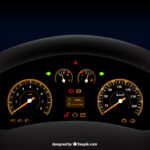How to Use Your Turn Signal

The turn signal lever is often found to the left of the steering wheel on vehicles. The lever can be moved up or down to indicate a turn to the right or left. If your turn signal does not automatically switch off following a turn or lane change, you should do so as quickly as you can.
Making your intentions known to other drivers in your vicinity is a crucial component of safe driving. It’s not difficult to use your turn signals, and you usually need to do so whenever you make a turn or lane change. You can communicate with other drivers on the road by giving a signal. This avoids accidents and keeps you and other drivers safe.
1.The turn signal lever is a long lever that is typically black or gray in color.
It can be found on the left side of the steering column. This lever will trigger a light to flash on the left or right side of your car depending on whether it is raised or lowered. Note: The turn signal will not make a sound or light the signal light on your car unless the car is running.
2. Use the turn signal to indicate a turn to the left. Wait until you are about 30 yards from the corner you wish to turn around before flashing your left turn signal. Make sure you are in the left-turn lane before using your left hand to gently depress the turn signal lever. On your instrument cluster, you will notice a flashing arrow pointing left when the turn signal locks in place. Additionally, you’ll hear a tick-tock sound that clicks in rhythm with the light’s flashing. This proves that the signal is functioning normally. Put your hand back on the wheel and go on with your drive.
Keep your right hand on the steering wheel and use your left hand to depress the signal lever. Note: Before making a turn, give other drivers plenty of warning. By law, you must begin signaling approximately 100 feet before your turn, but it is recommended that you begin indicating about a half-block ahead of when you intend to switch lanes or make a turn.
3. Make a right turn by signaling with your turn signal. To signal a right turn, wait until you are within about 30 yards of the corner you wish to round. Make sure you’re in the right-turn lane before using your left hand to raise the lever. Similar to what happens when you signal a left turn, a series of things happens after that.
Once the lever is raised, a dashboard instrument cluster arrow light will start blinking. Note: you may occasionally hear a metronome-like sound that clicks in rhythm with the instrument cluster’s flashing light.
4. Once your turn has been completed, be sure your turn signal is turned off. When you finish the turn, the indicator usually turns off automatically, but if the turn was less than 90 degrees, the signal might not. Check the display panel located directly behind and above your steering wheel. Pay attention for the signal’s periodic tick-tock sound as it blinks on and off.
(a) Reach over to the signal lever with your left hand and gently swivel it to the “off” position if you notice the indicator light blinking or hear the signal sound.
(b) It’s against the law and can confuse other drivers if you keep your turn signal on after you’ve made the turn.
5. Even if you are in a turning lane, signal your turn. Only left- or right-hand turns are permitted in some traffic lanes. Use the turn signal even if it would seem superfluous to do so since it should be evident given the lane you’re in. The direction you are going will help drivers who are unfamiliar with the region or who are unable to read the signs because of the number of cars in front of them in the lane understand that your lane is for turning in a specific direction.
Additionally, you must signal a turn according to the legislation.
6. Avoid activating your turn signal too soon. When there are no streets or alleyways between you and the location you intend to turn, only turn on your turn signal. Someone can mistakenly believe you are going into a parking lot or along a roadway if you switch on your signal too soon.
You can get into an accident or get cut off as a result of this confusion.







